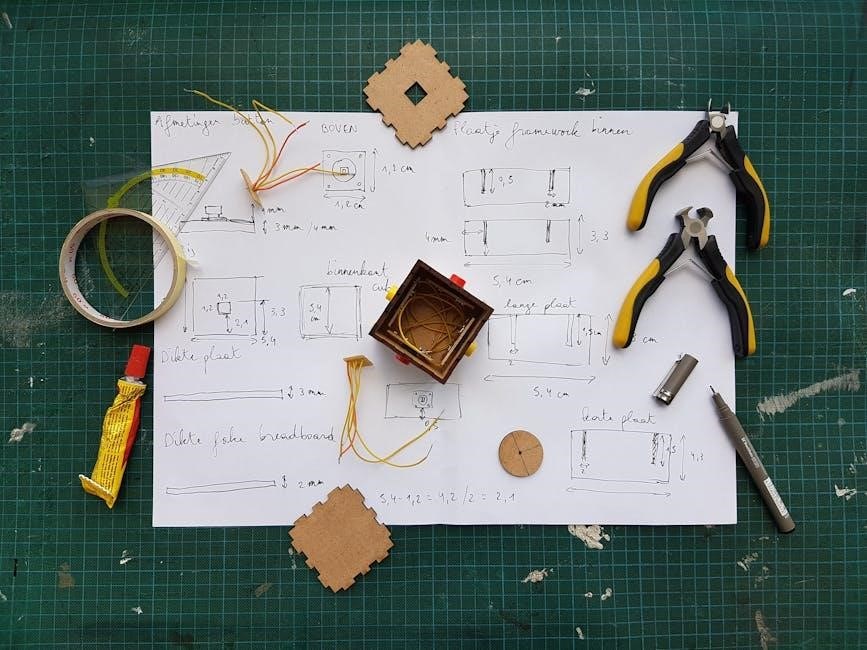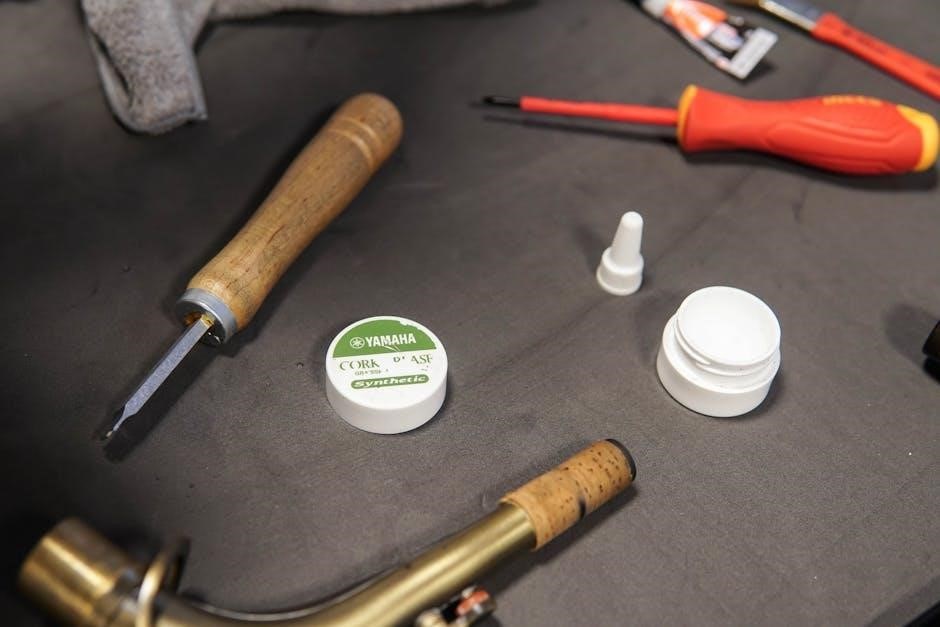
The Yamaha RX-V673 is a high-performance AV receiver offering exceptional sound quality, versatile connectivity, and advanced features for home theaters, ensuring an immersive entertainment experience with ease․
1․1 Overview of the Receiver
The Yamaha RX-V673 is a 7․2-channel AV receiver designed for high-quality home theater experiences․ It supports 4K and 3D video pass-through, along with wireless connectivity options like AirPlay and Bluetooth․ With built-in decoders for Dolby TrueHD and DTS-HD Master Audio, it delivers immersive sound․ The receiver also features Yamaha’s YPAO calibration system for optimal speaker setup and sound customization, making it a versatile choice for both enthusiasts and casual users seeking enhanced audio-visual performance․
1․2 Key Features and Capabilities
The Yamaha RX-V673 boasts advanced features such as HDMI 4K upscaling, multi-zone audio support, and wireless connectivity via Wi-Fi and Bluetooth․ It includes Yamaha’s YPAO room calibration system for precise speaker tuning and supports high-resolution audio formats․ Additional features like AirPlay compatibility and a user-friendly interface enhance its functionality, catering to both home theater enthusiasts and those seeking a seamless entertainment experience with versatile control options and enhanced sound quality․

Unpacking and Initial Setup
Carefully unpack the Yamaha RX-V673, ensuring all components are intact․ Place it on a stable, well-ventilated surface and connect essential devices like the TV and speakers․ Follow the setup guide for a smooth installation process, ensuring proper cable management and power supply connections to avoid any operational issues․
2․1 Unpacking the Yamaha RX-V673
When unpacking the Yamaha RX-V673, carefully remove the receiver from its box and inspect for any visible damage․ Ensure all included accessories, such as the remote control, power cord, and manual, are present․ Handle the unit with care to prevent scratches or damage․ Place it on a soft cloth or padding during unpacking to avoid surface marks․ Verify the package contents match the list provided in the manual to ensure nothing is missing․ Properly dispose of the packaging materials to maintain an organized workspace․
2․2 Placement and Installation Tips
Place the Yamaha RX-V673 in a well-ventilated area to prevent overheating․ Ensure it is at least 8 inches away from walls or obstructions for optimal airflow․ Avoid direct sunlight and moisture to maintain performance and longevity․ Install the receiver on a sturdy, flat surface or rack to prevent vibration and ensure stability․ Keep it away from other heat sources and electronic devices to minimize interference․ Always level the unit for proper operation and connectivity․ Allow sufficient space around the receiver for adequate cooling and easy access to ports․ Position it centrally or near your TV and components to streamline cable management and reduce signal loss․
2․3 Connecting Basic Components
Connect your TV to the Yamaha RX-V673 using an HDMI cable․ Link your Blu-ray player, gaming console, and other devices to the receiver’s HDMI inputs for seamless audio routing․ Ensure all HDMI cables are securely plugged into the correct ports to avoid signal loss․ Connect speakers to the corresponding terminals, matching positive and negative wires․ For subwoofers, use an RCA cable or LFE connection for optimal bass integration․ Power on the receiver and TV, then cycle through input sources to test connections․ Refer to the manual for specific port labels and configurations to ensure proper setup․ Use high-quality cables to maintain sound and video quality․ Follow the on-screen prompts to configure the receiver settings for each connected device․ Double-check all connections to prevent signal issues and ensure a smooth setup experience․
2․4 Initial Power-On and Setup
Plug the Yamaha RX-V673 into a power source and turn it on using the power button․ Use the remote control to navigate the on-screen setup menu․ Select the input source for your connected devices and configure basic settings like HDMI audio format and speaker configuration․ Ensure all components are recognized and properly connected․ Refer to the manual for guidance on advanced settings․ Complete the initial setup to enjoy optimal performance from your home theater system․

Remote Control Functionality
The Yamaha RX-V673 remote offers intuitive control, enabling seamless navigation through settings, input selection, and volume adjustments for a tailored home theater experience․
3․1 Understanding the Remote Control Layout
The Yamaha RX-V673 remote control features a logical layout designed for easy navigation․ The power button is centrally located, with volume controls nearby for quick adjustments․ Input selection buttons allow seamless switching between connected devices, while mode buttons enable customization of sound settings․ Dedicated buttons for HDMI, USB, and scene selections simplify access to key functions․ The remote’s intuitive design ensures users can effortlessly manage their home theater experience without confusion․
3․2 Programming the Remote for Customized Control
The Yamaha RX-V673 remote can be programmed for personalized control, allowing users to tailor functions to their preferences․ By accessing the remote’s settings menu, users can reassign buttons, create custom macros, and even adjust responsiveness․ This feature enhances convenience, enabling one-touch operation for frequently used functions․ Additionally, the remote supports learning functionality, allowing it to mimic commands from other devices’ remotes, centralizing control for a seamless home theater experience․
3․3 Troubleshooting Remote Control Issues
If the remote control isn’t functioning properly, check for battery depletion or signal obstruction․ Replace batteries with fresh ones and ensure no objects block the receiver’s infrared sensor․ If issues persist, reset the remote by removing batteries for 10 seconds․ Verify that the receiver’s IR sensor is clean and unobstructed․ For advanced troubleshooting, refer to the Yamaha RX-V673 manual or use the Yamaha remote control app as an alternative solution․

Network and Wireless Connectivity
The Yamaha RX-V673 supports seamless wireless connectivity, enabling Wi-Fi streaming and internet radio access․ Easily integrate with compatible devices for enhanced audio streaming and smart home control․
4․1 Setting Up Wi-Fi and Network Connections
To connect the Yamaha RX-V673 to your network, start by ensuring the receiver is in standby mode․ Use the remote to navigate to the Setup menu, then select Network settings․ Choose your router’s SSID from the available Wi-Fi options and enter the password using the on-screen keyboard․ Once connected, the receiver will confirm the network status․ For wired connections, use an Ethernet cable to link the receiver to your router directly․ Ensure proper connectivity for optimal performance․
4․2 Accessing Online Features and Services
After establishing a network connection, access online features by navigating to the Network menu using the remote․ Select Online Services to explore streaming platforms like Spotify or Tidal․ Log in to your accounts to access music and content․ Ensure a stable internet connection for uninterrupted service․ Refer to the manual for detailed instructions on configuring these features․
4․3 Troubleshooting Network-Related Problems
If experiencing network issues, restart the router and receiver․ Check the Network menu for connection status․ Ensure the Wi-Fi password is correct․ If problems persist, reset network settings via the Setup menu․ For firmware-related issues, update to the latest version․ Consult the Yamaha support website for additional troubleshooting guides․ Always verify cable connections and network stability for optimal performance․

Sound Customization and Calibration
This section guides users through refining audio settings, optimizing speaker configurations, and utilizing advanced calibration tools to achieve a tailored, high-quality listening experience for any setup․
5;1 Adjusting Equalizer Settings
The Yamaha RX-V673 allows precise sound customization through its built-in equalizer․ Users can adjust frequency bands to enhance bass, treble, or mid-range for a personalized audio experience․ Access the EQ settings via the on-screen menu or remote control․ Select from predefined modes or manually tweak each frequency to suit your preference․ This feature ensures optimal sound quality for movies, music, or gaming, delivering a tailored listening experience in any setup․
5․2 Configuring Sound Modes for Different Scenarios
The Yamaha RX-V673 offers multiple sound modes tailored for various scenarios․ Movie mode enhances dialog clarity and surround effects, while Music mode optimizes stereo playback․ Game mode reduces latency for an immersive gaming experience․ Additionally, Sports and Night modes adapt audio for specific viewing needs, ensuring dynamic sound reproduction․ These preset modes can be easily selected via the remote or on-screen menu, providing a seamless listening experience for any content type or environment․
5․3 Calibrating Speaker Settings for Optimal Sound
Calibrating speaker settings on the Yamaha RX-V673 ensures balanced audio reproduction․ Use the built-in YPAO (Yamaha Parametric Acoustic Optimizer) to automatically adjust speaker levels, distances, and frequencies based on room acoustics․ Manual adjustments are also possible for fine-tuning bass, treble, and crossover settings․ Proper calibration enhances clarity, bass response, and overall soundstage, delivering an immersive listening experience tailored to your space and speaker configuration․ Regular recalibration is recommended for optimal performance in changing environments․

HDMI and 4K Support
The Yamaha RX-V673 supports advanced HDMI and 4K capabilities, enabling seamless video pass-through and upscaling for stunning visuals․ Ensure optimal connectivity for your modern devices․
6․1 Understanding HDMI Port Configuration
The Yamaha RX-V673 features multiple HDMI ports designed for versatile connectivity․ Each port supports 4K resolution, ensuring compatibility with modern devices like Blu-ray players, gaming consoles, and TVs․ Proper configuration involves identifying input and output ports, with some supporting ARC (Audio Return Channel) for enhanced audio routing․ Ensure devices are connected to the correct ports to optimize performance․ Refer to the manual for specific port assignments and capabilities to achieve the best setup for your home theater system․
6․2 Enabling 4K Pass-Through and Upscaling
The Yamaha RX-V673 supports 4K pass-through and upscaling, ensuring pristine video quality․ Enable these features via the HDMI setup menu to maintain original resolution and enhance lower-resolution content․ Configure the output settings to match your display capabilities․ This ensures compatibility and optimal performance for movies, games, and streaming devices․ Proper setup guarantees a vivid and immersive viewing experience, leveraging the receiver’s advanced video processing capabilities․
6․3 Troubleshooting HDMI Connectivity Issues
If experiencing HDMI connectivity issues, ensure all cables are securely connected and compatible with 4K standards․ Restart the receiver and connected devices to reset the HDMI handshake․ Check for loose or damaged cables and replace if necessary․ Verify that the correct HDMI input is selected on your display․ If problems persist, update the receiver’s firmware or perform a factory reset to restore default settings and resolve connectivity conflicts effectively․

Multi-Zone Functionality
The Yamaha RX-V673 supports multi-zone audio, enabling different sound sources to play in multiple areas simultaneously, enhancing flexibility and immersive listening experiences for various home entertainment setups․
7․1 Setting Up and Configuring Multi-Zone Audio
To configure multi-zone audio on the Yamaha RX-V673, connect zone-compatible speakers or amplifiers to the designated Zone 2 and Zone 3 terminals․ Access the menu to enable zones and assign sources․ Ensure proper speaker impedance for optimal performance․ Use the remote to select sources for each zone independently․ Calibration may be needed for balanced sound across zones․ Follow on-screen instructions for a seamless setup․
7․2 Controlling Multiple Zones with the Remote
The Yamaha RX-V673 remote allows seamless control of multi-zone audio, enabling independent source selection and volume adjustment for each zone․ Press the ‘Zone’ button to switch between zones, then use the remote to select inputs or adjust settings․ Use the ‘Zone Control’ menu for advanced customization․ Ensure the remote is properly synced with the receiver for smooth operation․ This feature enhances flexibility, letting you manage multiple zones effortlessly from one device․
If experiencing issues with multi-zone audio, check all speaker and HDMI connections for stability․ Ensure correct source selection and zone configuration in the receiver’s menu․ Verify volume levels and mute settings for each zone․ Restart the receiver and remote to reset functionality․ If problems persist, refer to the Yamaha RX-V673 manual for detailed diagnostic steps or contact customer support for further assistance․ Consistent power supply and updated firmware are crucial for optimal performance․ Identify and resolve common problems like no sound, connectivity issues, or distortion by checking connections, settings, and ensuring proper calibration․ Resetting the receiver often helps․ Sound distortion can occur due to improper speaker settings, loose connections, or high volume levels․ Check all wires for secure connections and ensure volume is within recommended limits․ Adjust the equalizer settings to balance frequencies and minimize clipping․ If distortion persists, reset the receiver or perform a factory reset․ Regularly calibrate speaker settings to maintain optimal sound quality and prevent distortion issues․ Connectivity issues with speakers often stem from loose connections or incorrect settings․ Ensure all speaker wires are securely connected to the receiver and speakers․ Verify that the speaker settings in the menu match your setup; If no sound is coming from specific channels, check for corrosion or damage on the cables․ Restart the receiver and test the speakers․ If issues persist, reset the speaker settings or update the firmware for optimal performance․ If the remote control isn’t functioning, first check the batteries and ensure they are installed correctly․ Verify that no obstacles are blocking the infrared signal․ Clean the remote’s sensors and the receiver’s IR sensor with a soft cloth․ If issues persist, reset the remote by removing the batteries for 30 seconds․ Update the receiver’s firmware to ensure compatibility․ If problems remain, contact Yamaha support for further assistance or replacement options․ Regular firmware updates enhance performance and add new features․ Perform routine maintenance by cleaning vents and checking for updates to ensure optimal functionality and longevity․ To ensure optimal performance, regularly check for firmware updates via the receiver’s network connection․ Navigate to the Setup menu, select System, and choose Update․ If an update is available, download and install it․ After installation, restart the receiver to apply changes․ Always follow on-screen instructions carefully to avoid interruptions during the update process․ Verify the update in the system information menu to confirm successful installation․ To reset the Yamaha RX-V673 to its default settings, press the Menu button on the remote, navigate to Setup > System, and select Factory Reset․ Enter the password (default is 0000) and confirm․ The receiver will restart, restoring all settings to their original state․ Note that this will erase all custom settings, so ensure you have backups before proceeding․ After the reset, the receiver will need to be reconfigured from scratch․ Regular maintenance ensures optimal performance of the Yamaha RX-V673․ Clean the receiver with a soft, dry cloth to prevent dust buildup․ Avoid exposure to moisture and extreme temperatures․ Power cycle the unit monthly by unplugging it for 10 seconds to reset internal components․ Use a surge protector to safeguard against power spikes․ Update firmware periodically for the latest features and improvements․ Store the receiver in a well-ventilated area and avoid stacking objects on top of it․ Always refer to the manual for specific care instructions․ Avoid exposing the Yamaha RX-V673 to moisture, extreme temperatures, or physical stress․ Ensure proper ventilation to prevent overheating․ Handle the receiver with care to avoid damage․ When handling the Yamaha RX-V673, always follow safety guidelines to prevent damage or harm․ Avoid exposing the receiver to moisture, extreme temperatures, or physical stress․ Ensure proper ventilation to prevent overheating․ Keep the unit away from direct sunlight and flammable materials․ Disconnect the power cord before cleaning or performing maintenance․ Never insert objects into the vents or openings․ Follow the manual’s instructions carefully and use only authorized Yamaha parts for repairs or upgrades․ Regularly inspect cables and connections for wear or damage to ensure safe operation․ Proper handling and care are essential to maintain the Yamaha RX-V673’s performance and longevity․ Clean the unit with a soft, dry cloth, avoiding harsh chemicals or liquids․ Handle the receiver by its edges to prevent fingerprints on the display․ Avoid stacking objects on top of it to ensure proper airflow․ Use only Yamaha-approved accessories and follow the manual for updates or repairs․ Regularly update firmware to ensure optimal functionality․ Store the receiver in a cool, dry place when not in use․ When storing the Yamaha RX-V673, use the original packaging to protect it from dust and damage․ Place the receiver in a cool, dry environment, avoiding direct sunlight and moisture․ Store accessories like cables and remotes in labeled compartments to prevent tangling or loss․ Ensure the receiver is disconnected from power and all cables are securely wrapped․ Avoid stacking heavy objects on the receiver or its accessories to maintain their condition and functionality․ The Yamaha RX-V673 offers exceptional performance, versatile features, and ease of use, making it a top choice for home theater enthusiasts․ Explore its advanced capabilities and enjoy a premium audio-visual experience․ The Yamaha RX-V673 is a powerful AV receiver offering 4K and HDR support, Wi-Fi and Bluetooth connectivity, and multi-zone audio capabilities․ Equipped with YPAO sound calibration and HDMI 2․0 ports, it ensures immersive sound quality․ Dolby Atmos and DTS:X compatibility enhance the cinematic experience․ With a user-friendly interface and robust remote control, it seamlessly integrates with modern home theaters, providing versatility and high-performance audio for movies, music, and gaming․ Take full advantage of the Yamaha RX-V673’s advanced features to elevate your home theater experience․ Experiment with 4K HDR pass-through, Dolby Atmos, and DTS:X for cinematic sound․ Discover multi-zone audio for whole-house entertainment and utilize built-in Wi-Fi for seamless music streaming․ Explore calibration tools like YPAO to optimize performance․ Dive into the user-friendly interface to personalize settings and unlock the receiver’s full potential for unparalleled audio and visual fidelity in every scenario․ Regular maintenance is crucial to ensure the Yamaha RX-V673 performs optimally and lasts longer․ Clean the unit periodically to prevent dust buildup, which can cause overheating․ Check and tighten all connections to maintain signal integrity․ Update firmware regularly for improved functionality and security․ Properly store cables and accessories to avoid damage․ By following these steps, you can enjoy reliable performance and preserve the receiver’s quality over time․ Refer to the manual or Yamaha support for detailed guidance․ Explore official Yamaha support for detailed guides, online communities for user discussions, and recommended accessories to enhance your RX-V673 experience․ Visit Yamaha’s official website for comprehensive support and detailed documentation on the RX-V673․ Access user manuals, firmware updates, and troubleshooting guides to optimize your receiver’s performance․ Engage with online forums like AVS Forum and Reddit to connect with other Yamaha RX-V673 users․ Share experiences, seek advice, and learn tips from enthusiasts and experts for optimizing your home theater setup․ To enhance your Yamaha RX-V673 experience, consider high-quality HDMI 2․1 cables for 4K support, external DACs for improved audio processing, and wireless rear speakers for immersive sound․ Upgrading to premium speaker wire ensures clearer signal transmission․ Additionally, explore compatible subwoofers for deeper bass and wireless adapters for seamless connectivity․ These accessories are widely available at tech stores and online marketplaces, ensuring your setup remains cutting-edge and optimized for performance․7․3 Troubleshooting Multi-Zone Audio Problems
Troubleshooting Common Issues
8․1 Identifying and Resolving Sound Distortion
8․2 Fixing Connectivity Problems with Speakers
8․3 Solving Remote Control Malfunction

Firmware Updates and Maintenance
9․1 Checking for and Installing Firmware Updates
9․2 Performing a Factory Reset
9․3 Regular Maintenance Tips for the Receiver

Safety Precautions and Handling
10․1 Understanding Safety Guidelines
10․2 Proper Handling and Care of the Receiver
10․3 Storing the Receiver and Accessories
11․1 Summary of Key Features and Benefits
11․2 Encouragement to Explore Advanced Features
11․3 Importance of Regular Maintenance

Additional Resources
12․1 Official Yamaha Support and Documentation
12․2 Online Communities and Forums
12․3 Recommended Accessories and Upgrades